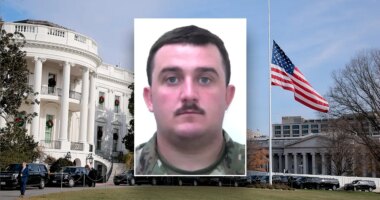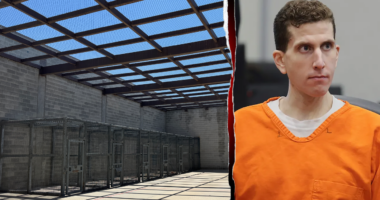Share this @internewscast.com
WHEN Air India Flight AI171 crashed in Ahmedabad and blazed up into a huge fireball, many believed that no one would have survived.
When video surfaced of 40-year-old Brit Vishwash Ramesh staggering away from the crash site on his own legs, experts were baffled and quickly began to speculate how he managed to survive the ordeal.
Many were also stunned to witness the London resident nonchalantly recounting his brush with death to Indian Prime Minister Narendra Modi and the local media just a day afterward.
Crash analysts from around the world have now weighed in on how they think the miracle survivor managed to cheat certain death.
Vishwash was sitting in seat 11A when the flight bound for London Gatwick crashed into a doctors’ hostel in western India, resulting in the deaths of his 241 fellow passengers and crew, along with others on the ground.
The Boeing Dreamliner 787-8 “came to a standstill mid-air” according to sole survivor Vishwash, and then crashed less than a minute after taking off.
Investigators are still combing over footage and evidence to uncover what exactly caused the crash.
But experts are also trying to dissect Vishwash’s story – and are attempting to theorise how he survived the unsurvivable.
The Brit, whose family is from Leicester, told local media that he was able to push open the plane’s fuselage by the emergency door and get out before the plane blew up.
It is currently unclear whether the opening Vishwash “slipped out” of was the emergency door or a rupture in the aircraft’s fuselage.
But aerospace and aviation professor Graham Braithwaite speculated the lucky Brit may have actually been flung out of the wreckage.
He said: “The aircraft was loaded with fuel and it crashed into a heavily populated area.
“I can only imagine that he was thrown from the wreckage, and that somehow as it crashed, what it hit managed to absorb some of the impact.”
He added: “Looking at the scene, I would imagine that the disruption to the aircraft would have been huge.
“If anybody could have got out, then they probably could have just gone out in a gap in the fuselage – you’d struggle to infer from this, therefore, that is the seat you must always sit in.”
The expert also said that surviving a crash like this was more a matter of being lucky about where a passenger is sat.
Meanwhile, former senior crash investigator, Tony Cable, told the Guardian his theory on how the jet having its nose up at the moment it crashed may have helped Vishwash escape.
He explained: “The aircraft was pretty nose up when it hit the buildings.
“It has presumably broken open in an area of the fuselage adjacent to this guy and fortuitously he has popped out without major injury.”
He also explained that the impact of the crash could have broken a part of the plane, or the emergency door itself, giving the Brit a chance to escape death.
Another expert weighed in on the importance of Vishwash’s seat selection of 11A.
Engineering safety professor John McDermid said that his choice of seat may have given the lucky Brit more time to escape.
Seat 11A is positioned on the left side of the aircraft’s body, right next to an emergency door, and has extra leg room because it is the first row of economy seats behind business class.
And this specific location on board the plane may have meant that Vishwash was given seconds more to get out of the burning jet.
Other passengers sat in regular seats may have been crushed on impact due to their proximity to the seats in front of them, according to the expert.
Professor McDermid also said: ” My suspicion is that because of the nature of the impact, he was in a strong part of the airplane at the front edge of the wing.
“There is not just the fuselage, but the extra structure of the wing to protect from the compression of the fuselage.”
He added, highlighting the importance of seat 11A: “It’s possible that the impact loosened the door and he could kick it out and get out.
“The external door was only just in front of him so he didn’t have far to go.”
Another analyst doubled down on the seat’s crucial location within the jet.
Fire evacuation expert professor Ed Galea said: “The fact that anyone has survived is miraculous.”
But he put Vishwash’s fortune down the seats proximity to the emergency exit.
In his own research of plane crashes, he found that people sitting within five rows of a serviceable exit have a better chance of surviving than those sat more than five rows away from one.
The expert added that when he travels, he always tries to reserve a seat within five rows of an emergency exit to boost his odds of survival.
Another theory for how Vishwash survived was also made after shocking footage of the plane’s final moments showed what may have been the emergency door flying away from the jet.
Unbelievable footage showed the moment the Dreamliner went down – with a mysterious object seen spinning away seconds before the plane blew up into a fireball.
The theories about how Vishwash survived also come as a veteran pilot revealed what he believes caused the devastating crash itself
YouTuber and commercial airline pilot Captain Steve Chen gave his chilling theory after watching the horrifying video of the disaster.
Some 279 people have been killed following the horror smash in Ahmedabad, India.
Investigations are still ongoing into the cause of the crash – with at least one of the black boxes recovered from the wreck.
Both pilot Captain Sumeet Sabharwal and co-pilot Clive Kunder and believed to be among the dead.
Mr Sabharwal, who had 8,200 hours of experience, while his colleague Mr Kunder had 1,100 hours.
Vishwash could also provide key clues as to what happened to the plane.
He said cabin lights began flickering before the jet sank through the air and crashed.
Recalling the moments before tragedy, Vishwash, from Leicester, said: “When the flight took off, within five to 10 seconds it felt like it was stuck in the air.
“Suddenly, the lights started flickering – green and white.
“The aircraft wasn’t gaining altitude and was just gliding before it suddenly slammed into a building and exploded.”
Vishwash’s flickering lights revelation comes after a passenger, who took the plane the day before the crash, claimed electrical parts such as the back-of-seat screens weren’t working.
Aviation experts have speculated that the reports of dodgy electrics could be a sign of a power failure, possibly explaining the crash.
Air India is keeping an open mind as to what went wrong and caused the deaths of 52 Brits.
Theories being considered include issues with the engine thrust, flaps and landing gear – as well as a bird strike and a pilot error.
India’s dark aviation history
A LONDON-BOUND Air India flight crashed in the western Indian city of Ahmedabad on Thursday.
The following are details of some other airline accidents in India in recent decades:
AUGUST 2020
At least 18 people died and 16 were severely injured when an Air India Express Boeing 737 plane skidded off the runway in the southern city of Kozhikode during heavy rain, plunged into a valley and crashed nose-first into the ground.
MAY 2010
An Air India Boeing 737 flight from Dubai overshot the runway at the airport in the southern city of Mangaluru and crashed into a ravine, killing 158 people on board.
JULY 2000
More than 50 people were killed when a state-owned Alliance Air flight between Kolkata and the capital, New Delhi, crashed in a residential area of the eastern city of Patna.




























